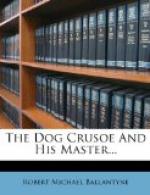The prairies have often been compared, most justly, to the ocean. There is the same wide circle of space bounded on all sides by the horizon; there is the same swell, or undulation, or succession of long low unbroken waves that marks the ocean when it is calm; they are canopied by the same pure sky, and swept by the same untrammelled breezes. There are islands, too—clumps of trees and willow-bushes—which rise out of this grassy ocean to break and relieve its uniformity; and these vary in size and numbers as do the isles of ocean, being numerous in some places, while in others they are so scarce that the traveller does not meet one in a long day’s journey. Thousands of beautiful flowers decked the greensward, and numbers of little birds hopped about among them.
“Now, lads,” said Joe Blunt, reining up, “our troubles begin to-day.”
“Our troubles?—our joys, you mean!” exclaimed Dick Varley.
“P’r’aps I don’t mean nothin’ o’ the sort,” retorted Joe. “Man wos never intended to swaller his joys without a strong mixtur’ o’ troubles. I s’pose he couldn’t stand ’em pure. Ye see we’ve got to the prairie now—”
“One blind hoss might see dat!” interrupted Henri.
“An’ we may or may not diskiver buffalo. An’ water’s scarce, too, so we’ll need to look out for it pretty sharp, I guess, else we’ll lose our horses, in which case we may as well give out at once. Besides, there’s rattlesnakes about in sandy places, we’ll ha’ to look out for them; an’ there’s badger holes, we’ll need to look sharp for them lest the horses put their feet in ’em; an’ there’s Injuns, who’ll look out pretty sharp for us if they once get wind that we’re in them parts.”
“Oui, yis, mes boys; and there’s rain, and tunder, and lightin’,” added Henri, pointing to a dark cloud which was seen rising on the horizon ahead of them.
“It’ll be rain,” remarked Joe; “but there’s no thunder in the air jist now. We’ll make for yonder clump o’ bushes and lay by till it’s past.”
Turning a little to the right of the course they had been following, the hunters galloped along one of the hollows between the prairie waves before mentioned, in the direction of a clump of willows. Before reaching it, however, they passed over a bleak and barren plain where there was neither flower nor bird. Here they were suddenly arrested by a most extraordinary sight—at least it was so to Dick Varley, who had never seen the like before. This was a colony of what Joe called “prairie-dogs.” On first beholding them Crusoe uttered a sort of half growl, half bark of surprise, cocked his tail and ears, and instantly prepared to charge; but he glanced up at his master first for permission. Observing that his finger and his look commanded “silence,” he dropped his tail at once and stepped to the rear. He did not, however, cease to regard the prairie-dogs with intense curiosity.
These remarkable little creatures have been egregiously misnamed by the hunters of the west, for they bear not the slightest resemblance to dogs, either in formation or habits. They are, in fact, the marmot, and in size are little larger than squirrels, which animals they resemble in some degree. They burrow under the light soil, and throw it up in mounds like moles.




